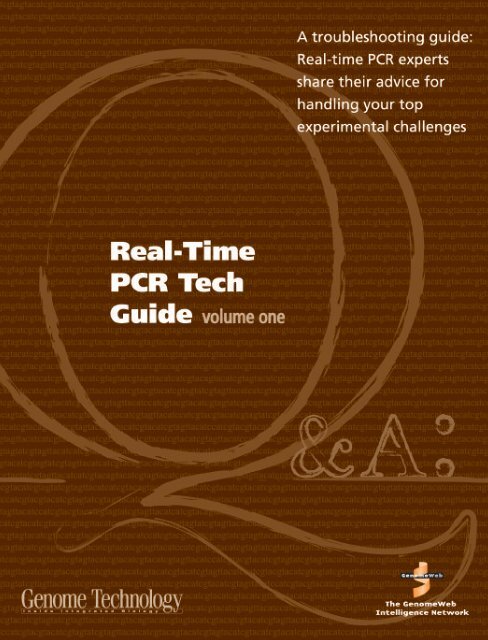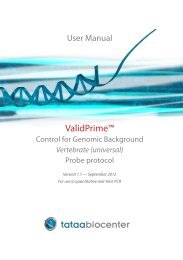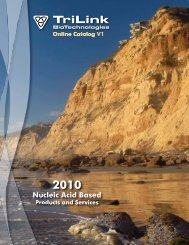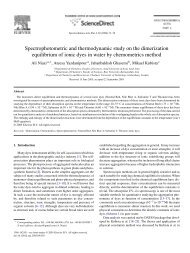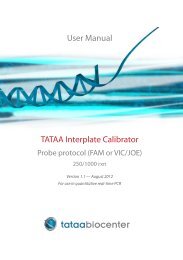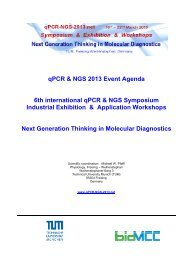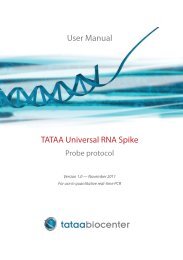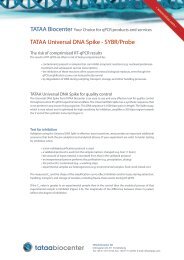AAA Real-Time PCR Tech Guide - TATAA Biocenter
AAA Real-Time PCR Tech Guide - TATAA Biocenter
AAA Real-Time PCR Tech Guide - TATAA Biocenter
You also want an ePaper? Increase the reach of your titles
YUMPU automatically turns print PDFs into web optimized ePapers that Google loves.
AMPLIFICATION CELL BIOLOGY CLONING MICROARRAYSNUCLEIC ACIDANALYSISPROTEIN FUNCTION& ANALYSISQUANTITATIVE<strong>PCR</strong>SOFTWARESOLUTIONSMX3005P SystemMost FlexibleMX3000P ®Most AffordableSystemPerformance runs in the family.Choose the personal Q<strong>PCR</strong> system that’s right for you.Stratagene now offers two affordable, fully-featured quantitative <strong>PCR</strong>(Q<strong>PCR</strong>) systems. The new five-color Mx3005P Q<strong>PCR</strong> System includesexpanded features to support a wider range of real-time Q<strong>PCR</strong>applications, such as simultaneous five-target detection and alternativeQ<strong>PCR</strong> probe chemistries. The Mx3000P ® Q<strong>PCR</strong> System is still the mostaffordably priced four-color 96-well system available.• A four- or five-color instrument, withuser-selected filters• Advanced optical system design for truemultiplexing capability, and widerapplication support• Q<strong>PCR</strong> Software with enhanced data analysisand export functionalityNeed More Information? Give Us A Call:Stratagene USA and CanadaOrder: (800) 424-5444 x3<strong>Tech</strong>nical Services: (800) 894-1304 x2Stratagene Japan K.K.Order: 03-5159-2060<strong>Tech</strong>nical Services: 03-5159-2070Stratagene EuropeOrder: 00800-7000-7000<strong>Tech</strong>nical Services: 00800-7400-7400www.stratagene.comMx3000P ® is a registered trademark of Stratagene in the United States.Mx3005P is a trademark of Stratagene in the United States.Purchase of this product is accompanied by a license under the foreign counterparts ofU.S. Patent Nos. 4,683,195, 4,683,202 and 4,965,188 covering the Polymerase ChainReaction (“<strong>PCR</strong>”) process, where such process is covered by patents. This instrument isan Authorized ThermalCycler for use with applications licenses available from AppliedBiosystems. Its use with Authorized Reagents also provides a limited <strong>PCR</strong> license inaccordance with the label rights accompanying such reagents.
Table of contentsLetter from the Editor . . . . . . . . . . . . . . . . . . . . . . .5Index of Experts . . . . . . . . . . . . . . . . . . . . . . . . . . .5Q1: How do you select andvalidate normalization factors? . . . . . . . . . . .7Q2: What are your tips forimproving assay design? . . . . . . . . . . . . . . .11Q3: How do you choose ordevelop standard protocols? . . . . . . . . . . . .13Q4: What do you do to achievebetter primer specificity? . . . . . . . . . . . . . . .15Q5: How do you enable amplificationfrom damaged or impure samples? . . . . . . . .16List of Resources . . . . . . . . . . . . . . . . . . . . . . . . . .18 Genome <strong>Tech</strong>nology <strong>Real</strong>-<strong>Time</strong> <strong>PCR</strong> <strong>Tech</strong> <strong>Guide</strong> vol.1 3
Letter from the editorWelcome to the inaugural issue ofGenome <strong>Tech</strong>nology’s reference guideseries. This slim volume contains our firstinstallment of answers to quantitative<strong>PCR</strong> problems.Despite its youth, quantitative <strong>PCR</strong>has become ubiquitous in any lab dealingin nucleic acid quantification. The technology isconceptually simple, easy to use, and widely applicable.But these virtues belie a host of challenges, fromimproving assay design to working with degradedsamples. These topics and more are addressed by ourinternational panel of experts. Their field-tested tips areIndex of expertsgathered here to help you troubleshoot your waythrough any experimental scenario involving real-time<strong>PCR</strong>. The guide itself is user-friendly, sleek, and completewith a resource list based on expert advice highlightedin the text. In short, it’s made to keep on the bench,preferably within easy reach of your lab’s q<strong>PCR</strong> workstation.This guide owes its existence to the generosity ofour contributors, whose time, expertise, and counselhave transformed our initial questions into an accessibletechnical manual. With special thanks to them, we hopeyou enjoy the following pages.— Jennifer CrebsPamela “Scottie” AdamsDirector, Molecular Biology Core FacilityTrudeau InstituteMikael KubistaProfessor, Head of R&D<strong>TATAA</strong> <strong>Biocenter</strong>Claus Lindbjerg AndersenAssociate ProfessorMolecular Diagnostic LaboratoryDepartment of Clinical BiochemistryAarhus University HospitalShawn LevyAssistant ProfessorVanderbilt UniversityVladimir BenesHead, Genomics Core Facility, ScientificCore Facilities, Services & <strong>Tech</strong>nologies UnitEuropean Molecular Biology LaboratoryJo VandesompeleCenter for Medical GeneticsGhent University HospitalStephen BustinProfessor of Molecular ScienceQueen Mary University of LondonMichael ZianniManager/Research AssociatePlant-Microbe Genomics FacilityOhio State UniversityGenome <strong>Tech</strong>nology <strong>Real</strong>-<strong>Time</strong> <strong>PCR</strong> <strong>Tech</strong> <strong>Guide</strong> vol. 1 5
How do you select andvalidate normalizationfactors?We test a panel of normalization genes — GAPDH, β-actin, β 2-microglobulin, GUS, and HPRT — toconvince ourselves that expression is stable in thetissues and conditions we are using. GAPDH appearsto be very stable in the tissues that we examine duringvarious infections in the mouse. GAPDH is also usefulbecause it can be used as an indication of genomicDNA contamination when used as a no transcription(-RT) control.— Pamela AdamsSelection of candidates: I choose a set of candidategenes, typically five to 10, which I expect not to showexpression variation under the conditions in the givenexperiment. Optimally the genes are selected basedon some form of evidence (e.g. microarray data), butthis is not a prerequisite (it will most likely increase thechance of identifying a good stabile expressed geneamong the candidates).Validation of expression stability: I then purchaseor design real-time RT-<strong>PCR</strong> assays to these genes andtest these on samples identical to, or at least verysimilar to, the samples in the given experiment. Forclinical samples I have a minimum of eight samplesper sample group. I recommend that the generatedC t values are transferred to linear values usingstandard curves. If standard curves are not applied,caution should be taken to verify equal amplificationefficiencies of all assays; alternatively, measuresshould be taken to correct for differences inamplification efficiencies.I then estimate the intra- and inter-groupexpression variation of the individual assays usingthe free-ware NormFinder. Finally, I select thecandidate with the least expression variation as mynormalization gene.Alternatively, one can use a combination of twoto three of the candidates to form a normalizationfactor — make sure that the candidates included haveopposite directed inter-group variation. Otherwise thenormalization factor is no better than using thecandidates individually!— Claus AndersenMicroarray data represent a treasure trove of referencegenes for organisms where such data are available.Papers out there talk about genes expressed innormal tissues, and for some people that it is a veryuseful clue, but there are people who are workingwith organisms that are not so well characterized bymicroarrays. For these people, there is only testing,going through the literature, and more testing. Testingrequires first selecting panels of reference genes: runthem in a few situations, see if they are stable. Thiscan be cumbersome, and there is the trouble thatpeople are prone to compromise C t difference,although they really shouldn’t. This is a real issue thatwill need debate.Some people share [Jo Vandesompele’s] viewregarding normalization factors, but it must beremembered that there is a difference between theideal world and the world of daily research. There willbe no such thing as a general set of reference genes.People need to be open minded and look to otherbiochemical pathways that are unrelated tothe process they are (continued on page 9)Genome <strong>Tech</strong>nology <strong>Real</strong>-<strong>Time</strong> <strong>PCR</strong> <strong>Tech</strong> <strong>Guide</strong> vol. 1 7
<strong>Real</strong> <strong>Time</strong> <strong>PCR</strong> --That Works!SYBR ® Premix Ex Taq (Perfect <strong>Real</strong> <strong>Time</strong>)SYBR ® Premix Ex Taq(Perfect <strong>Real</strong> <strong>Time</strong>) is a real time <strong>PCR</strong>premix from Takara which is unsurpassed for high-speed, highspecificityapplication results. This 2X concentration premixcombines the high sensitivity and performance offered byTakara’s Ex Taq Hot Start DNA Polymerase, SYBR ® Green I,plus a newly formulated R-<strong>PCR</strong> buffer which provides superiorspecificity and increased amplification efficiency. Your result isexceptional real time <strong>PCR</strong> results quickly and easily.•Versatility: use on many real-time <strong>PCR</strong> instrumentssuch as: Smart Cycler ® , LightCycler ® , Applied Biosystemsq<strong>PCR</strong> systems, MJ Opticon ® , iCycler ® and RotorGene• High Sensitivity: as few as 100 copies using SYBR ®Green I detection.• Wide Dynamic Range: this product possesses adynamic range of 7-8 orders (λ DNA template).• High Speed Capability: works with high speed q<strong>PCR</strong>instruments.• Convenient: supplied in an easy-to-use format with theSYBR ® Green I dye.Performance of SYBR ® Premix Ex Taq (Perfect <strong>Real</strong> <strong>Time</strong>) (left panel)vs. Roche's Fast Start DNA Master SYBR ® Green I (right panel) using aRoche LightCycler ® . Takara's SYBR ® Premix Ex Taq demonstrates anexcellent melting curve, particularly when low copy number templates areamplified. For more data demonstrating SYBR ® Premix Ex Taq performanceon other instruments, please see our website at www.takaramirusbio.com.Order Your FREE Sample Today!www.takaramirusbio.com888-251-6618Ex Taq is a trademark of Takara Bio Inc. SYBR ® is a registered trademark of Molecular Probes, Inc. Lightcycler ® isaregistered trademark of a member of the Roche group. RotorGene is a trademark of Corbett Research. SmartCycler ® is a registered trademark of Cepheid. iCycler and MJ Opticon are trademark of BioRad laboratories Inc.Takara <strong>PCR</strong> Related Products are sold under a licensing arrangement with Roche Molecular Systems andF. Hoffman La Roche Ltd. and Applied Biosystems. Takara Bio’s Hot-Start <strong>PCR</strong>-Related products are licensedunder U.S. Patent 5,338,671 and 5,587,287 and corresponding patents in other countries.
Easily programmabletemperature gradient8101-A112D © 2004 Eppendorf AG Optional motorizedheated lid GLP-compliantenvironment Three differentblock formatsLicensedand authorizedfor <strong>PCR</strong>Get your lab up to speed!A new tempo that defies speed limits—rapidlyevolving <strong>PCR</strong> technology meets its match with theMastercycler ® ep line of high-speed thermal cyclers.Mastercycler ep is one of the fastest instruments in itsclass. A combination of high ramping speeds (up to 6°C/s)and outstanding temperature regulation accuracy ensureextremely precise and fast <strong>PCR</strong> performance.The new Mastercycler ep system: Extremely fast heating and cooling Standard <strong>PCR</strong> run times of ~30 min Intuitive graphic programming Superior temperature control technology No restrictions—use kits, reagents and consumablesof your choice Remarkably quiet operationFor more information visit www.mastercycler.comwww.eppendorf.com • Email: info@eppendorf.com • Application hotline: 516-515-2258In the U.S.: Eppendorf North America, Inc. 800-645-3050 • In Canada: Brinkmann Instruments (Canada) Ltd. 800-263-8715Practice of the patented polymerase chain reaction (<strong>PCR</strong>) process requires a license. The Eppendorf ® Thermal Cycler is an Authorized Thermal Cycler and may be used with <strong>PCR</strong> licenses available from Applied Biosystems.Its use with Authorized Reagents also provides a limited <strong>PCR</strong> license in accordance with the label rights accompanying such reagents.
How do you chooseor develop standardprotocols?The protocol is dictated by the science. Whatquestion do you want to answer? I would searchthe literature for situations in which others have askedsimilar questions and see what protocols have beensuccessful. Stephen Bustin’s book, A-Z ofQuantitative <strong>PCR</strong>, is a wonderful resource andMichael Pffafl’s webpage contains a wealth ofinformation.— Pamela AdamsRoughly, the q<strong>PCR</strong> protocol can be divided intothree parts: isolation of specimen and total RNA fromit, a reverse transcription step, and a quantitative <strong>PCR</strong>step. Nowadays, there is no doubt that the last step isperhaps the most straightforward from the threethanks to numerous high-quality kits available on themarket. It is not to say that one shouldn’t workcarefully, but not so many things can go wrong here,provided that one is approaching it with the rightattitude. It is the first two steps which canconsiderably influence the outcome of theexperiment.Basically, the protocol should be very robust interms of performance. Although ideally one wouldlike to have one protocol that fits all, there aregroups of protocols that may be more applicable.That is, if you know that some amplicons of someRNAs are folding close to 3’, in which case youcannot have amplicon designed there, then it isnecessary to move to 5’ end and adjust your strategyof priming the RT reaction. Ultimately, regardlesswhatever protocol has been chosen, the mostimportant factor is consistency within the cohort ofanalyzed samples.Preferentially, for any type of priming, theRT polymerase should be as thermostable andprocessive as possible. Mostly we are usingSuperScript III and testing transcripts by Roche to seereproducibility over many runs. It is important to tryto work with material that is as close to material onewill get in a real experiment as possible. It is alsobetter to use cDNA, not the plasmid, as the latter istoo optimal. It is important to find the right measure,for too much of material can be inhibiting, forexample.We use a two-step method because the RTproduct can be archived; Stephen Bustin usestranscript-specific primers, but the product of thisreaction cannot be used for assaying any othertranscript, unfortunately.Basically, people tend to think that q<strong>PCR</strong> is [an]easy method — it looks so deceivingly simple — butit really needs to be recognized that there are risks andcaveats involved.— Vladimir BenesWe have developed our own protocols:(a) In our hands, the most reliable quantificationof RNA is achieved using target-specific primers for theRT step. We empirically choose an optimal primer pairfrom four potential candidates for each target gene.(b) We use Mfold to determine the best locationfor reverse (RT) primers and usually carry out the RTstep at 60°C for three minutes using Tth polymerase.We also use Mfold to determine the optimal positionfor the forward primer. (continued on page 17)Genome <strong>Tech</strong>nology <strong>Real</strong>-<strong>Time</strong> <strong>PCR</strong> <strong>Tech</strong> <strong>Guide</strong> vol.1 13
What do you do to achievebetter primer specificity?The best way to achieve primer specificity is bycareful assay design. I prefer the extra assurance ofspecificity provided by the Taqman assay.— Pamela AdamsAlthough it helps to Blast the primers to see if thereis any secondary binding within transcriptometested, people are not always working withorganisms where sequence information is available. Ithink the ultimate test of your primers is a standardRT-<strong>PCR</strong> and checking its outcome on the highpercentageagarose gel. If the result is satisfying,we’re running a small sample set on [the] q<strong>PCR</strong>instrument with SYBR Green and look at thedissociation curve. If the primer pair passes this test,then it’s suitable for work.— Vladimir BenesTake nucleic acid secondary structure into account,perform the RT step at 60°C, reduce primerconcentration as much as possible, and if all else fails,reverse transcribe from mRNA.— Stephen BustinWe don’t experience primer specificity to be aproblem, but poorly designed primers may give riseto primer-dimer products. This is minimized byproper primer design including avoiding any 3’complementarity, using low primer concentrations,hot-start, and short annealing times.— Mikael KubistaPrimer specificity is best achieved through properdesign of the assay. Trying to optimize conditionsto get a sub-optimal primer set to perform at highefficiency is typically more problematic than doing agood design or using a validated design to start with.— Shawn LevyLimit GC content of the 3’ end of the primer(maximum 40 percent GC content for last five bases).After primer design, we routinely do a Blast specificitysearch using the ‘search for short, nearly exactmatches’ option at NCBI’s Blast portal and usingboth forward and reverse primer sequence separatedby three N’s as one input sequence.For more difficult designs where there is lessfreedom to choose the sequence to amplify (e.g. SNPgenotyping or splice variant quantification), wesometimes add agents to enhance specificity, such asDMSO, or increase annealing temperature. We alsokeep the MgCl 2 and primer concentrations limited(max 3.5 mM and 250 nM for SYBR Green I assays,respectively), as higher concentrations allow moremispriming.— Jo VandesompeleMost customers use SYBR Green and have limitedbudgets, so they use thermal cycle changes instead ofordering different primers. Most customers (1) raisethe annealing temperature, (2) collect data at atemperature intermediate to extension and melting,and/or (3) use five to 10 seconds for annealing.— Michael ZianniGenome <strong>Tech</strong>nology <strong>Real</strong>-<strong>Time</strong> <strong>PCR</strong> <strong>Tech</strong> <strong>Guide</strong> vol. 1 15
How do you enableamplification from damagedor impure samples?If your amplicon is really short, then you still can usethe sample and get decent curves, even if the mRNAhas been heavily degraded. However, cDNA can beobtained only by priming the RT reaction withrandom primers. It’s always good to check using theAgilent Bioanalyzer to see the profile of thesample’s total RNA.One thing that has been introduced in the lab isan assay assessing the scale of degradation. In regardto this, I recommend the work of Tania Nolan andStephen Bustin. They have introduced two assaysthat are useful. One is the 3’:5’ strategy, that ischecking quality of the 3’ and 5’ ends of selectedtranscript by q<strong>PCR</strong> and look to see if there is any C tcurve difference. If the mRNA is intact, then youshould get the same C t values for both ends. Nolanand Bustin also invented a method to assesspresence of inhibitors; nevertheless, people try topush their luck here.So, if a sample is very precious, with no chanceof recovery and such that you cannot apply anyfurther purification steps, then the length of theamplicon is very important. If the issue is degradation,you cannot do oligo-dT priming, but are priming withrandom primers, it is important that it is consistentwith all samples in a panel. In any case, there is alwayshope in these situations (of course, if it cannot bedone, then sorry).— Vladimir BenesIt is important to realize that results fromimpure/damaged RNA must be treated with caution.We screen our RNA using the Agilent Bioanalyzer,assess the 3’:5’ ratios of reference genes, and screenfor inhibitors present in the sample.— Stephen BustinWhen amplifying damaged samples we believe oneshould use specific RT primers, which are the same asone set of the <strong>PCR</strong> primers, to minimize variation inthe RT step due to RNA degradation.For complex samples it is important to accountfor matrix effects, which can be done either by in situcalibration (standard dilution) or standard addition(Stahlberg et al., 2003).— Mikael KubistaRNA isolation procedures that are optimized for theconditions of the sample (frozen or FFPE, tissue or celllines, etc.) make a tremendous difference in thequality of RNA. When the quality of the RNA cannotbe made better, ensuring that all of the RNA that willbe used in differential comparisons has the sameoverall quality is very important to ensure consistentand comparable results. If impurities are present,cleaning up the RNA samples prior to cDNA synthesisor cleaning up the cDNA material can be very helpful.— Shawn LevyWe have experienced that it is fairly easy to obtainbeautiful amplification plots for degraded samples.The important question, however, is how reliabledata are coming from such samples. In a recentstudy, we demonstrated that expression patternsmight vary in relation to the degradation status of16 <strong>Real</strong>-<strong>Time</strong> <strong>PCR</strong> <strong>Tech</strong> <strong>Guide</strong> vol. 1 Genome <strong>Tech</strong>nology
the samples (Perez-Novo et al., 2005). In the samepaper, we recommended not to analyze intact anddegraded samples together.With respect to working with impure samples,we try to address this issue by performing propernucleic acid extraction, followed by extensive qualitycontrol, such as inspecting the UV absorptionspectrum of the nucleic acids and performing capillarygel electrophoresis to assess the length of theribosomal RNA molecules.— Jo VandesompeleQ2: What are your tips forimproving assay design?(continued from p.11)testing, the better you get. Of course, with thenumber of vendors selling pre-validated assays, theeasiest way to improve your assay design is to buy onerather than build one.— Shawn LevyPerform extensive in silico assay evaluation, using Blastspecificity analysis of the primer pair, Mfold secondarystructure prediction of the amplicon sequence(significant structures reduce amplification efficiency),search for SNPs present in the primer annealingregion, and transcript variant analysis (alternativeaxons, etc.).We are currently implementing a Web-based andfreely available in silico assay evaluation analysispipeline for user-designed assays. This module will bepart of the next update of our real-time <strong>PCR</strong> primerand probe database (RTPrimerDB) and aims atstreamlining assay quality prediction prior toexperimental evaluation, based on above citedestablished in silico tools, such as Blast specificitysearch, Mfold secondary structure analysis, presenceof SNPs or plain sequence errors, and graphicalvisualization of the aligned primer sequences on thetarget gene.— Jo VandesompeleDo a thorough optimization at the start focusingon annealing temperature, template concentration,primer concentration, and utilizing the best benchtechnique as possible while setting up the reactions. Imake sure customers realize there are no shortcuts ormagic bullets, and thorough optimizationis critical.— Michael ZianniQ3: How do you choose ordevelop standard protocols?(continued from p.13)(c) A standard curve is developed for each target.We aim to achieve an amplification efficiency of morethan 95 percent. If that is not possible, we aim toachieve consistent amplification efficiencies betweenruns, monitored using a standard curve as well as apositive control sample.— Stephen BustinWhen using standard protocols, it is importantthat all assays are optimized under standardconditions. If this is not the case, matrix effects frombiological samples will complicate interpretationseriously.— Mikael KubistaWe start with recommended or established protocolsand then make modifications as dictated byexperimental needs or try optimizations to improveperformance or efficiency. For the most part, we useestablished and well used protocols — usually fromthe manufacturer. If it isn’t broken, don’t fix it.— Shawn LevyStandard protocols or operating procedures arevery important in order to achieve consistent andaccurate results. As our lab was one of the earlyadopters of q<strong>PCR</strong> technology, we developed our ownexperimental protocols, from nucleic acid qualitycontrol, over DNase treatment, cDNA synthesis, <strong>PCR</strong>reaction setup, and data analysis. It is important torigorously control the quality at each step and useboth positive and negative controls to evaluate thereliability of the results.— Jo VandesompeleGenome <strong>Tech</strong>nology <strong>Real</strong>-<strong>Time</strong> <strong>PCR</strong> <strong>Tech</strong> <strong>Guide</strong> vol. 1 17
List of resourcesIn the preceding pages, our experts referred to anumber of resources. We’ve compiled theirrecommendations in the following list. Whether you’rea q<strong>PCR</strong> ace or apprentice, these Web tools andpublications are sure to be helpful.PublicationsAndersen CL, Ledet-Jensen J, Ørntoft T (2004).Normalization of real-time quantitative RT-<strong>PCR</strong> data:a model based variance estimation approach toidentify genes suited for normalization, applied tobladder and colon cancer data sets.Cancer Research, 64: 5245-5250.Bustin SA (2004).A-Z of Quantitative <strong>PCR</strong>.International University Line: La Jolla.Bustin SA, Benes V, Nolan T, Pfaffl MW (2005).Quantitative real-time RT-<strong>PCR</strong> - a perspective.J Mol Endocrinol, 34(3): 597-601.Bustin SA, Nolan T (2004).Pitfalls of quantitative reverse transcriptionpolymerase chain reaction.J Biomol <strong>Tech</strong>, 15: 155-166.Hartshorn C, Anshelevich A, Wangh LJ (2005).Rapid, single-tube method for quantitativepreparation and analysis of RNA and DNA in samplesas small as one cell.BMC Biotechnol, 5(1): 2.Perez-Novo CA, Claeys C, Speleman F, VanCauwenberge P, Bachert C, Vandesompele J (2005).Impact of RNA quality on reference geneexpression stability.Biotechniques, 39(1): 52, 54, 56.Stahlberg A, Aman P, Ridell B, Mostad P,Kubista M (2003).Quantitative real-time <strong>PCR</strong> method for detectionof B-lymphocyte monoclonality by comparison ofkappa and lambda immunoglobulin light chainexpression.Clin Chem, 49(1): 51-59.Vandesompele J, De Preter K, Pattyn F, Poppe B, VanRoy N, De Paepe A, Speleman F (2002).Accurate normalization of real-time quantitativeRT-<strong>PCR</strong> data by geometric averaging of multipleinternal control genes.Genome Biol, 3(7): RESEARCH0034.WebsitesAgilent Bioanalyzer: http://www.chem.agilent.com/GenEx: http://www.multid.se/GenEx/genex.htm/Gene Quantification web page (edited by MichaelW. Pfaffl): http://www.gene-quantification.info/GeNorm: http://medgen.ugent.be/~jvdesomp/genorm/NCBI’s Basic Local Alignment Search Tool:http://www.ncbi.nlm.nih.gov/blast/NormFinder:http://www.mdl.dk/publicationsnormfinder.htm/OLIGO Primer Analysis Software:http://www.oligo.net/Premier Biosoft Beacon Designer:http://www.premierbiosoft.com/molecular_beacons/<strong>Real</strong> <strong>Time</strong> <strong>PCR</strong> Primer and Probe Database(RTPrimerDB): http://medgen.ugent.be/rtprimerdb/<strong>TATAA</strong> <strong>Biocenter</strong>: http://www.tataa.com18 <strong>Real</strong>-<strong>Time</strong> <strong>PCR</strong> <strong>Tech</strong> <strong>Guide</strong> vol. 1 Genome <strong>Tech</strong>nology
Optimized, Flexible, Sensitive...We Have the Right Q<strong>PCR</strong> Reagent for You.Sigma’s broad range of Q<strong>PCR</strong>reagents provide the flexibilityneeded to meet your Q<strong>PCR</strong> needs.From probe based to SYBR ® Greendye based Q<strong>PCR</strong>, our products arecompatible with all instrumentsand optimized to help you achievesuccessful results.• Optimized ReadyMixes let youchoose the detection method.• Compatible with tube or platebased instruments.• Greater sensitivity, efficiency, andlinear response.Probe based Quantitative <strong>PCR</strong>Product NumberProduct NameD6442JumpStart TM Taq ReadyMix for High Throughput Quantitative<strong>PCR</strong> (blended with Reference dye)D7440JumpStart Taq ReadyMix for Quantitative <strong>PCR</strong>D9191JumpStart Taq ReadyMix with dUTP for Quantitative <strong>PCR</strong>SYBR Green based Quantitative <strong>PCR</strong>Product NumberProduct NameS9194SYBR Green JumpStart Taq ReadyMix for High ThroughputQuantitative <strong>PCR</strong> (blended with Reference dye)S4438SYBR Green JumpStart Taq ReadyMix for Quantitative <strong>PCR</strong>S5193SYBR Green JumpStart Taq ReadyMix without Magnesium ChlorideCapillary based Quantitative <strong>PCR</strong>Product NumberProduct NameS1816SYBR Green JumpStart Taq ReadyMix for Quantitative<strong>PCR</strong>, Capillary FormulationD9191JumpStart Taq ReadyMix with dUTP for Quantitative <strong>PCR</strong>Quantitative RT-<strong>PCR</strong>Product NumberProduct NameQR0100SYBR Green Quantitative RT-<strong>PCR</strong> KitQR0200Quantitiave RT-<strong>PCR</strong> ReadyMix for probe based applicationsFor more information and to evaluate Sigma’s Quantitative <strong>PCR</strong> products,contact us at: sigma-aldrich.com/qpcr1 or call 1-800-325-3010SYBR ® Green nucleic acid stain is licensed from Molecular Probes, Inc. under U.S. Patent No. 5,436,134 for use in <strong>Real</strong>-<strong>Time</strong> <strong>PCR</strong> byend-users for research and development only. SYBR ® is a registered trademark of Molecular Probes, Inc.LEADERSHIP IN LIFE SCIENCE, HIGH TECHNOLOGY AND SERVICESIGMA-ALDRICH CORPORATION • BOX 14508 • ST. LOUIS • MISSOURI 63178 • USA
iQ 5 Multicolor <strong>Real</strong>-<strong>Time</strong><strong>PCR</strong> Detection SystemPass the iQ TestWhat do all these images have in common? The answer is 5. Introducing the iQ5 real-time <strong>PCR</strong> detectionsystem and reagents, bringing true five-color detection capabilities to all of your real-time <strong>PCR</strong> applications.Five reasons why the iQ5 is the ultimate system for value and flexibility:■■■■Powerful thermal gradientOptical detection system featuresuser-changeable filter setsGene expression analysis by relative quantity(C T ) or normalized expression (C T )Customizable software reports that offer comprehensivesummaries of assay run conditions, data graphs and tables,and data analysis parameters■Optimized multiplex reagents: increase throughput,control costs, and maximize your data output withthe new iQ multiplex powermixNEWFor more information, visit us on the Web atwww.bio-rad.com/products/iQ5/ orwww.bio-rad.com/supermixes/iQ5 real-time <strong>PCR</strong> detection systemand iQ multiplex powermixVisit us on the Web at discover.bio-rad.comCall toll free at 1-800-4BIORAD (1-800-424-6723);outside the US, contact your local sales office.


